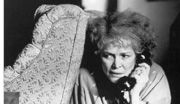THERE’S A STRAIN in American literature beginning with Kerouac and the Beats, unsteadily extending to Charles Bukowski, and finally teetering over into Hubert Selby Jr. From Bukowski’s Barfly to Selby’s Last Exit to Brooklyn, you can see the romanticization of a certain kind of drunk, down-and-out emotional ethos that equates suffering with truth. The slurred, outer-borough accents are supposed to signal sincerity, the inarticulateness poetry—as if every rambling wastrel on the barstool next to you has the tortured soul and sensitivity of an artist. Maybe they do, but in this supercharged adaptation of Selby’s 1978 novel, director Darren Aronofsky’s virtuoso technique can’t conceal his source material’s limitations.
REQUIEM FOR A DREAM
directed by Darren Aronofsky with Ellen Burstyn, Jared Leto, Jennifer Connelly, and Marlon Wayans opens October 27 at Neptune
Set in the Coney Island area of Brooklyn, Requiem for a Dream initially, incongruously sounds like an episode of The Honeymooners. In her dingy, claustrophobic apartment, we meet Sara and Harry Goldfarb (Ellen Burstyn and Jared Leto), a quarrelsome mother and son. “Why you gowtah make me feel so guilty, Ma?” he wails. Well, because he just swiped her television set to support his heroin habit. When he and his best friend (Marlon Wayans) pawn the TV, they shoot up and groove to hip-hop music in their baggy clothes. What decade are we in? The ’50s of Selby’s youth or Aronofsky’s hip, millennial present?
Initially, this disorientation is fun, like the drugs, as Pi director Aronofsky dazzles us with camera effects. Split screens, shock cutting, bold angles, blanched colors—he uses every vertiginous trick in the book (and then some), making for remarkable imagery. Close-ups of bent spoons, zip-lock bags, cotton balls, syringes, dilating eyes, and febrile microscopic cells convey the irresistible heady rush of what Harry and pals call “pushing off.” In this hyperkinetic way, Dream presents the junkie idyll that Harry shares with his spoiled Manhattan girlfriend (Jennifer Connelly). Resting in each other’s arms on a black leather couch seems like Eden itself for these two overgrown innocents.
NATURALLY, THEN, paradise must be lost, as addiction takes its toll. Paralleling Harry’s habit is Sara’s diet-pill binge, triggered by an invitation to appear in an infomercial audience. She’s hooked on her television dreamworld, suckered by its promise, destroyed by its insidious lure. Sara’s TV is like Harry’s smack. In case you missed that, Dream repeats the idea—its only idea—about ten thousand times. Here—we’ll say it again: Sara’s TV is like Harry’s smack. Everyone’s a junkie in one form or another. Once you move beyond that profound realization, five minutes into Dream, there’s not much more to appreciate beyond brave acting and wild technique.
Burstyn, in particular, depicts a harrowing descent into madness, allowing herself to be unflatteringly photographed as few other actresses would dare. An Oscar-winner for 1974’s Alice Doesn’t Live Here Anymore, she creates a memorably pathetic figure. Leto has comparatively little to do but mope; Wayans shows range beyond his Scary Movie and TV background, but it’s the gorgeous Connelly who gets Dream delivered without benefit of an MPAA rating. Her degradation is particularly ugly (yet predictable). As with Jennifer Jason Leigh’s gang rape in Last Exit to Brooklyn, there’s something suspect about Selby’s preoccupation with female martyrdom. Women seem to exist in his world to be crucified for male edification, fodder for their puerile novels.
Already signed up to direct the next Batman installment, Aronofsky deserves better than Selby (so does his cast). As Dream tediously repeats itself, his flashy style can’t disguise its lack of story or character development. Films like Gus Van Sant’s Drugstore Cowboy and Steven Soderbergh’s forthcoming Traffic show how a talented director can use the insular drug culture to explore character and society more broadly. But for those stuck inside Selby’s time capsule (audience included), nobody can find what they’re looking for: escape.








